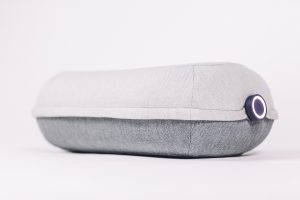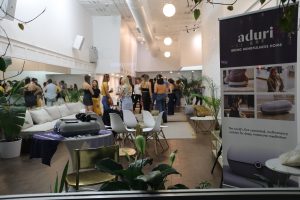Every week, the NYU Entrepreneurial Institute elects a Startup of the Week. We then invite the founders of these startups to share a blog post with our community. These posts can be inspirational, educational, or entertaining. Founders can share founding stories, resources, lessons, or anything else they want.
This blog post was written by Jesal Trivedi (Tisch '18), Founder of Aduri, creators of the Aduri mindful meditation cushion. Aduri creates products, rooted in mindfulness, that help people rest, recover and re-focus. Follow Aduri on IG.
“If you want to go fast, go alone. If you want to go far, go together.”
I was at a disadvantage when I started Aduri. I was a solo founder with no team, no money and trying to build a hardware/software company. I needed to put together a team. However, finding the right team can be one of the most difficult things you ever have to do as a founder, especially when you need to scale. So, how did I do it?
The short answer is: By making mistakes, learning from them, and sometimes getting pretty lucky.
As founders, we have to be Swiss Army Knives — being able to do, or figure out how to do, many things, often at the same time. I had to learn how to build a startup team by doing it. So far, I’ve been able to build a team of 8 incredibly talented and diverse individuals. Hopefully the lessons I've learned along the way can help you in your search for your dream team.
Here's what I learned in my journey to putting together my team:
Step 1: Prove to others the idea (and you) are worth investing their time into
You have an idea? Cool.
Now, what matters most is execution. Anyone can have an idea, but not everyone pulls it off. You have two sub-steps:
A. Socialize the idea
Start talking about it with your friends, get some fresh new perspectives on it. Don’t worry, no one is going to “take” your idea. Seriously, this should not be the reason why you don’t tell people. Getting diverse perspectives around your idea will unlock new ways to think about it. Also, you may find someone else in this sharing process who’s equally passionate about your idea and who is thinking about it in similar ways. If that happens, that’s great! You can now skip straight to Step 3. If not, you have a little more work to do.
B. Start building and learning
You have to prove to the potential future person you bring on (and to the startup community) that you have the ability to figure things out and make it work. If you don’t know how to build a prototype of what you are envisioning, learn how to build it. Most of it will not work as you want it to anyway — mine didn’t even work at all and I was practically Wizard of Oz’ing it. Despite how ugly it looked I was able to prove a very simple, important thing: people enjoyed using my prototype and told their friends about it. If fact, a few people asked how they could buy one. 🤯
Another way you can compliment this work is by going out and talking to who your potential customers. That way you can get some qualitative data around your product. I didn’t do this until later and it would have saved us some time to do it sooner.
At this point in my journey, my team size was: 1
Step 2: Sell the vision
So, you built your crappy prototype, and you got some street cred. Now you have to sell what you were trying to do.
I leaned on my strengths: design, marketing, brand and storytelling. We got fancy and made a video (that honestly didn’t describe anything), but it “looked cool”. Totally optional.
I hired a talented industrial designer (an investment) to design some renderings based on this prototype and a few crude sketches. I wanted to show the vision of what I was thinking. It worked and I was awarded some cash during the NYU InnoVention startup competition to build my v2.0, which was still cobbled together, but more “finished looking”.
This “semi-working” v2.0 prototype (and renderings/deck) then landed us a spot in Futureworks, the hardware startup incubator program funded by NYC.
Team Size: 1.25 (due to hired industrial designer)
Step 3: Find someone to help you do the next task that will 10x your product
Now you need to build a v3.0 with someone who actually knows what they are doing. This will require talking and showing your Frankenstein creation and hoping someone “kinda sees what you were doing there”.
Being in Futureworks helped not only build my network in the hardware space and eventually meet our next industrial designer, but also give me cred to get into the NYC Media Lab, an incubator funded and run by NYC. We leveraged that program and clout to hire a brainy intern from NYU Tandon Engineering, to build out our app and hardware. Finally some muscle.
Team Size: 3
Step 4: Move quickly
After the intern rotated off, we didn’t have an engineer and found one in a friend, a fellow classmate and a sharp hardware prototyping engineer who had observed the track record of Aduri over the last 1.5 years and wanted to contribute. I was able to raise some funding and we got started on developing the hardware. Combined with the designer I had met in the startup program, we developed a couple more refined prototypes. We were getting closer. I also brought on a talent mobile engineer I used to work with to build a very simple MVP version of our app.
Team size: 4
Step 5: Startup community
Unfortunately our Industrial designer had to transition to another project and couldn’t contribute any further, so we were left without a designer. We completed the NYU Summer Launchpad program, led by the NYU Entrepreneurial Institute, and presented our product at the program's Demo Day. There, a professor saw our product and thought she could connect us to another professor/industrial designer.
I can’t say this enough: the NYU Entrepreneurial Institute was incredible in giving us cred and being a wealth of knowledge and experience to lean on.
This new industrial designer not only had incredible experience designing high-end furniture and products, but she saw the vision and potential of what Aduri could be. We quickly hired her and found ourselves with a core product team. But, we didn’t have meditation content, all we had was the cushion. I had recently seen a friend's post on IG about his friend, an incredible meditation teacher. I met with her and brought her and her business partner, a talented sound designer and audio engineer, on the team to develop a few pieces of content that would complete a basic demo experience.
All the work we had done to participate in all those startup programs helped us build a startup community that we still tap into to this day.
Team size: 6
Step 6: Lean on your personal network, investors and mentors
I’ll keep this one short. Through connections, your investors and mentors will help you do a lot. My mentors' networks far surpass my own, and when I need to, I can ping my list and will usually get a few offers to help out.
We have brought some people on to the team (around the time we did our Kickstarter), from marketing and brand positioning who were great for that chapter of the company. Some of the product and content ideas are still being executed on today.
I was able to move quickly at the beginning as it was just me. But I’m confident that we would not have been able to get this far without the incredible and passionate team I have at Aduri. I’m incredibly grateful.
Current Team size: 9
In short, put in the work. Take advantage of your resources at NYU and NYC, share your idea with anyone who will listen, and keep your eyes open for people who may be as passionate as you are about what you're doing. Good luck out there!
COME SAY HI IN UNION SQUARE
Team Aduri will be at the Wellness Festival at Energi Wellness in Union Square this weekend (Jan 31). Come say hi!










